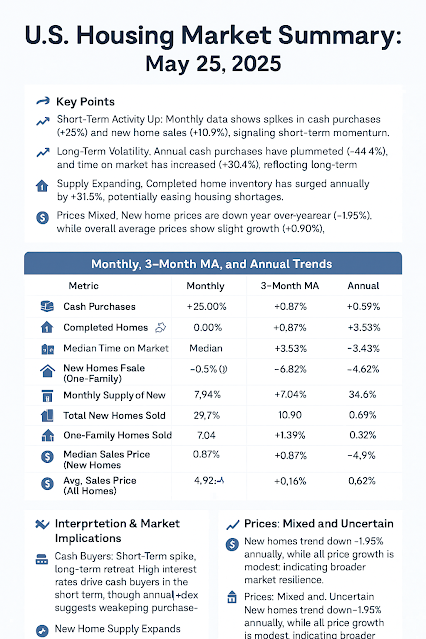As of May 25, 2025, the U.S. housing market continues to exhibit mixed signals, driven by evolving buyer behavior, shifting inventory levels, and dynamic pricing. Recent data reveals notable contrasts between short-term momentum and long-term uncertainty, offering both opportunities and caution for buyers, sellers, investors, and policymakers.
🔑 Key Trends at a Glance
-
📈 Short-Term Momentum:Cash purchases surged +25% month-over-month, and new one-family home sales increased +10.9%, reflecting temporary demand spikes.
-
🏗️ Supply Expansion:Completed new homes for sale are up +31.5% year-over-year, suggesting progress in addressing housing shortages.
-
🕒 Longer Time on Market:Newly completed homes are taking +30.4% longer to sell than they did a year ago — signaling cooling demand or buyer hesitation.
-
💵 Prices Mixed:New home median prices fell -1.95% annually, while overall average prices rose a modest +0.90%, highlighting diverging trends.
📊 Detailed Market Breakdown
| Metric | Monthly | 3-Month Avg | Annual |
|---|---|---|---|
| Cash Purchases | +25.00% | -11.11% | -44.44% |
| Completed Homes for Sale | 0.00% | +0.87% | +31.46% |
| Time on Market for New Homes | 0.00% | +3.53% | +30.43% |
| Total New Homes for Sale | -0.59% | +0.53% | +8.62% |
| Monthly Supply of New Homes | -10.99% | -3.30% | +5.19% |
| Total New Homes Sold | +7.94% | +6.82% | +4.62% |
| New One-Family Homes Sold | +10.90% | +4.08% | +3.34% |
| Median Sales Price (New Homes) | +0.87% | -1.80% | -1.95% |
| Average Sales Price (All Homes) | -1.39% | +0.11% | +0.90% |
| Median Sales Price (All Homes) | -0.57% | +0.19% | +0.82% |
🧠 Insights and Implications
🔹 For Buyers
-
With new home inventory expanding and prices softening, now may be a favorable time to negotiate.
-
Longer time on market gives buyers added leverage — especially for newly completed homes.
🔹 For Sellers
-
Adjusting pricing expectations and marketing strategies is key as homes sit on the market longer.
-
Sellers should be aware of the decline in cash buyers year-over-year, even if short-term spikes occur.
🔹 For Investors
-
Inventory growth and steady sales offer potential, but price fluctuations and slower turnover require caution.
-
High interest rates may continue to pressure certain segments of the market.
🔹 For Policymakers
-
The volatility in cash buyer behavior and persistent affordability concerns call for balanced housing and lending policies.
-
Continued support for new construction could help ease long-term supply issues.
🔗 Sources







